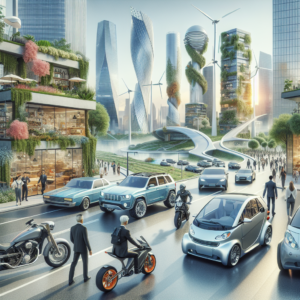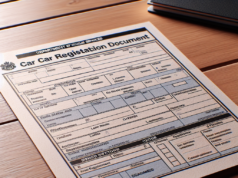Contents
- 1 1. Introduction to Self-Driving Cars: A Technological Revolution in Transportation
- 2 2. The Testing Landscape: Key Players and Their Innovative Approaches
- 3 3. Unanticipated Outcomes: Surprising Results from Recent Self-Driving Tests
- 4 4. Safety Concerns: Analyzing the Risks Associated with Autonomous Vehicles
- 5 5. Regulatory Challenges: Navigating the Legal Framework for Self-Driving Cars
- 6 6. The Road Ahead: Future Implications of Self-Driving Technology on Society

The advent of self-driving cars represents a significant technological revolution in the transportation sector, promising to reshape how we commute, transport goods, and interact with our urban environments. As major automotive manufacturers and tech companies invest heavily in autonomous vehicle technology, the implications of these innovations extend beyond mere convenience. Recent tests have unveiled not only the potential benefits of self-driving cars but also unexpected challenges and revelations that could influence the future of mobility. This article delves into the current landscape of self-driving car technology, exploring the key players involved, the surprising outcomes of recent tests, safety concerns, regulatory challenges, and the broader societal implications of this transformative technology.
1. Introduction to Self-Driving Cars: A Technological Revolution in Transportation
Self-driving cars, or autonomous vehicles, represent a groundbreaking shift in the transportation industry, integrating advanced technologies such as artificial intelligence, machine learning, and sophisticated sensor systems to navigate without human intervention. This innovation promises to enhance road safety, reduce traffic congestion, and provide mobility solutions for individuals unable to drive. As companies like Tesla, Waymo, and traditional automakers invest in research and development, the race to bring fully autonomous vehicles to market intensifies. The potential for self-driving cars to revolutionize urban planning, logistics, and personal mobility is immense, but it also raises critical questions about ethics, safety, and the future of work in the transportation sector.
2. The Testing Landscape: Key Players and Their Innovative Approaches
The landscape of self-driving car testing is dominated by a mix of established automotive giants and innovative tech startups. Companies such as Waymo, a subsidiary of Alphabet Inc., and Tesla have emerged as leaders in the field, employing diverse methodologies to refine their autonomous technologies. Waymo has focused on extensive real-world testing in urban environments, utilizing a fleet of modified Chrysler Pacifica minivans equipped with advanced sensors and AI algorithms. Conversely, Tesla’s approach leverages its vast network of customer vehicles to gather data, enhancing its Autopilot feature through over-the-air updates. Other players, including General Motors’ Cruise and Ford’s Argo AI, are also making significant strides, each adopting unique strategies to address the complexities of autonomous driving. This competitive landscape fosters innovation but also highlights the varying philosophies regarding safety, data collection, and user experience.
3. Unanticipated Outcomes: Surprising Results from Recent Self-Driving Tests
Recent self-driving car tests have yielded a series of surprising outcomes that challenge preconceived notions about autonomous technology. For instance, some tests have revealed that self-driving cars can struggle with complex urban scenarios, such as navigating roundabouts or responding to unpredictable pedestrian behavior. In one notable case, a fleet of autonomous vehicles was observed to exhibit erratic behavior when confronted with construction zones, leading to unexpected stops and detours. Additionally, data from these tests indicate that while self-driving cars can significantly reduce human error, they may also introduce new types of challenges, such as misinterpreting traffic signals or failing to recognize cyclists in certain conditions. These revelations underscore the need for ongoing refinement and adaptation of autonomous systems to ensure they can safely and effectively operate in diverse environments.
4. Safety Concerns: Analyzing the Risks Associated with Autonomous Vehicles
Despite the promise of enhanced safety through automation, significant concerns remain regarding the risks associated with self-driving vehicles. Critics argue that reliance on technology may lead to complacency among drivers and a false sense of security. High-profile accidents involving autonomous vehicles have raised questions about the reliability of sensor systems and the decision-making capabilities of AI algorithms. Moreover, the potential for software malfunctions or cyberattacks poses additional risks, as malicious actors could exploit vulnerabilities in autonomous systems. As self-driving technology continues to evolve, it is imperative for manufacturers to prioritize safety through rigorous testing, transparent reporting of incidents, and the development of robust cybersecurity measures to protect both passengers and pedestrians.
The rapid advancement of self-driving technology has outpaced the development of regulatory frameworks necessary to govern its deployment. Lawmakers and regulatory bodies face the daunting task of establishing guidelines that ensure public safety while fostering innovation. Current regulations vary widely across jurisdictions, creating a patchwork of laws that complicate testing and deployment. Key issues include liability in the event of accidents involving autonomous vehicles, the ethical implications of decision-making algorithms, and the need for standardized safety protocols. As stakeholders from the automotive industry, technology firms, and government agencies engage in dialogue, the establishment of a cohesive regulatory framework will be crucial to facilitating the safe integration of self-driving cars into the transportation ecosystem.
6. The Road Ahead: Future Implications of Self-Driving Technology on Society
The implications of self-driving technology extend far beyond the realm of transportation, potentially reshaping societal norms and economic structures. As autonomous vehicles become more prevalent, we may witness a decline in car ownership, leading to a shift in urban planning and public transportation systems. The rise of ride-sharing services powered by self-driving technology could reduce the need for parking spaces and encourage the development of pedestrian-friendly urban environments. Additionally, the automation of driving jobs raises significant concerns about job displacement in the transportation sector, necessitating a reevaluation of workforce training and support systems. As society navigates these changes, it will be essential to balance technological advancement with ethical considerations and the well-being of all stakeholders involved.
As self-driving technology continues to evolve, the revelations from recent tests serve as a reminder of both the potential and the challenges that lie ahead. The journey toward fully autonomous vehicles is fraught with complexities, requiring collaboration among industry leaders, regulators, and the public to ensure that the benefits of this technological revolution are realized safely and equitably. As we stand on the brink of a new era in transportation, the decisions made today will shape the future of mobility for generations to come.























